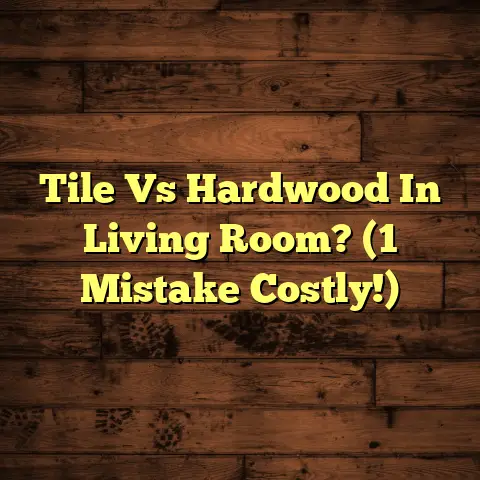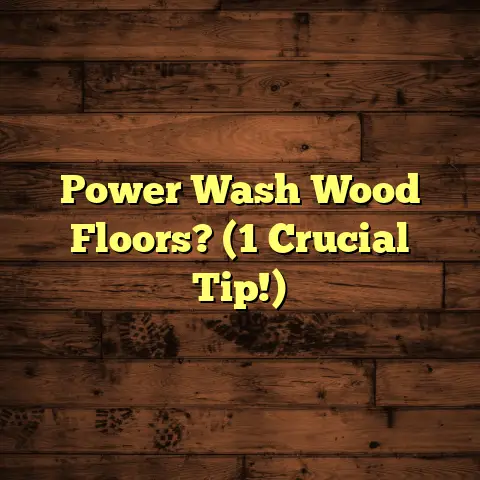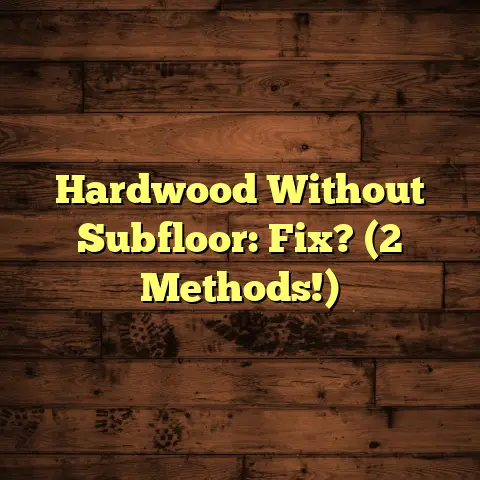Floor Makes Noise When Walked On? (Explained)
Have you ever walked across your floor and wondered why it suddenly sounds like a creaky old ship?
It can be quite baffling and, let’s be honest, a little annoying.
As a flooring contractor with years of experience, I’ve encountered this issue countless times.
Today, I want to share my insights and experiences regarding noisy floors, including the causes, solutions, and some helpful tips for both prevention and repair.
Why Does My Floor Make Noise?
Noise from floors can stem from various sources.
Sometimes it’s the result of natural wear and tear, while other times, it could be due to installation issues or environmental factors.
Here are some common culprits:
1. Movement in the Subfloor
One of the most prevalent causes of noise is the movement within the subfloor.
This often occurs when the subfloor is not securely fastened to the joists.
Over time, the fasteners can loosen, leading to creaks and squeaks with each step.
When I was working on a home renovation in an older house, I discovered that the subfloor had been installed using nails instead of screws.
The nails had loosened over the years, making the floor creak underfoot.
I had to go through and reinforce the subfloor with screws to eliminate the noise.
2. Expansion and Contraction
Wooden floors are particularly susceptible to noise caused by expansion and contraction.
Changes in humidity and temperature can cause wood to swell or shrink, leading to gaps between the planks that create noise when walked on.
I once installed hardwood flooring in a cabin near a lake.
The moisture levels fluctuated significantly with the seasons, leading to noticeable gaps in the winter months.
After some monitoring and discussion with the homeowners, I recommended using a humidifier during the winter to maintain a more stable moisture level in the home.
3. Poor Installation
I’ve seen my fair share of poorly installed flooring.
If the flooring was not laid down properly—such as not using enough adhesive or not allowing enough expansion space—this can lead to a cacophony of sounds.
On one occasion, I was called to fix a laminate flooring job that a DIY enthusiast had attempted.
They hadn’t left enough space at the walls for expansion, and as a result, the floor buckled and squeaked when walked on.
It was a lesson in the importance of following installation guidelines.
My Experience with Noisy Floors
I remember a project in a cozy bungalow in my neighborhood where I first encountered a particularly noisy hardwood floor.
The homeowners were frustrated as they had recently renovated, expecting their new floor to be silent and smooth.
After inspecting the area, I discovered that the subfloor was not properly secured to the joists.
This was an easy fix; I added more screws to tighten everything up.
However, I also had to address the expansion issue related to humidity since it was near a water source.
The Importance of Communication
One thing I learned from this experience was how vital communication is with clients.
The homeowners were understandably anxious about their investment and wanted reassurance that their new floor would be quiet and beautiful.
By clearly explaining the causes of their issues and how I planned to fix them, I was able to build trust and keep them informed throughout the process.
Solutions for Noisy Floors
If you find yourself dealing with noisy floors, here are some solutions based on my hands-on experience:
1. Reinforce the Subfloor
For those experiencing creaks due to movement in the subfloor, reinforcing it is often a good first step.
Adding screws or nails at strategic points can help stabilize the flooring.
When reinforcing a subfloor, I typically use screws rather than nails since screws hold better over time.
It’s advisable to place screws every 12-16 inches along joists for optimal support.
2. Use Lubricant
In some cases, applying a dry lubricant between the boards can help reduce friction and minimize noise.
Products like talcum powder or graphite powder work well for this purpose.
I often use talcum powder in spaces where two boards rub against each other.
Simply sprinkle a bit between the planks and walk over it; you’ll notice an immediate reduction in noise.
3. Check for Gaps
If your wooden floor is expanding and contracting, check for gaps between the planks.
You might need to consider replacing boards or adjusting them to ensure they fit snugly without excess space.
In one instance, I replaced several boards that had become too warped due to humidity changes.
By carefully measuring and selecting new pieces that matched closely in color and grain, I was able to restore both function and aesthetics.
Cost Estimation with FloorTally
When I tackle projects involving noisy floors, I often think about how much time and money could be saved with accurate cost estimates.
That’s where FloorTally comes in handy for me.
Using FloorTally allows me to pull local material and labor rates quickly.
For instance, when working on that bungalow renovation, I was able to generate an estimate for reinforcing the subfloor in just a few minutes.
This reliability helped me provide a transparent budget to my clients, making them feel at ease about the project costs.
During that particular project, we estimated about $150 for materials (screws and adhesive) and an additional $300 for labor.
Being upfront about these costs went a long way in maintaining client trust.
Common Challenges Encountered
Not every job goes smoothly, though.
One challenge I faced during a laminate installation was when I noticed unexpected noise after completion.
It turned out that the underlayment had been improperly installed.
The Unexpected Fix
Having to tear up part of the flooring to fix it not only took more time but also impacted my budget estimates.
This experience taught me the value of double-checking installation techniques and ensuring that all materials are compatible.
In situations like these, it’s crucial to communicate any changes effectively with clients so they understand why additional costs may arise.
Tips for Prevention
Here are some tips I’ve gathered over the years that can help prevent noisy floors:
- Proper Installation: Always ensure that flooring is installed according to manufacturer guidelines.
- Choose Quality Materials: Investing in better-quality materials can often lead to less noise in the long run.
- Control Humidity: Use dehumidifiers in areas prone to moisture issues and monitor humidity levels regularly.
- Regular Maintenance: Periodically check for loose boards or gaps in your flooring and address these issues before they escalate.
Understanding Different Flooring Options
When it comes to flooring choices, each material has its unique characteristics that affect sound levels:
Hardwood Flooring
Hardwood floors are beautiful but can creak if not installed properly or if they undergo expansion due to humidity changes.
I often advise clients considering hardwood options to think about their local climate.
In areas with high humidity, engineered hardwood may be more appropriate since it’s designed to resist moisture better than solid wood.
Laminate Flooring
Laminate can be quieter than hardwood but also has its pitfalls if not laid down correctly.
I recall a project where laminate was installed over concrete without proper underlayment.
This led to significant noise when walking on it because there was no cushioning between the hard surfaces.
Tile Flooring
Tile is generally quiet but can be cold and hard underfoot.
Additionally, if tiles are not installed properly or if there are gaps in grout lines, they may produce noise as well.
During one installation, I noticed some tiles were slightly uneven after installation due to inadequate leveling of the subfloor beneath them.
Fixing this required additional work but ultimately resulted in a much quieter floor.
Carpet Flooring
Carpet provides sound absorption benefits, making it an ideal choice for areas where noise is a concern.
In one home theater project I worked on, we opted for thick carpet padding beneath plush carpeting which not only kept noise levels down but also added comfort for movie nights.
The Final Word on Noisy Floors
If you’re dealing with noisy floors, don’t fret!
There are plenty of options and solutions available.
Whether it’s reinforcing your subfloor, addressing gaps, or even simply applying lubricant between boards, most issues can be resolved with some attention and care.
Remember, every flooring project is unique, so what worked for me might need adjustment for your specific situation.
Don’t hesitate to reach out for professional advice if needed—sometimes a fresh set of eyes can make all the difference!
If you have any experiences or tips of your own regarding noisy floors, I’d love to hear them!
Sharing knowledge only makes us all better at what we do.
Understanding Footfall Noise
Footfall noise is another aspect of noisy floors that many homeowners encounter but may not fully understand.
This type of noise refers specifically to sounds created when people walk on flooring surfaces—think squeaks from wooden floors or echoes from tile surfaces.
In many cases, footfall noise can be mitigated through proper insulation materials or underlayment during installation.
For example:
Underlayment Choices
Choosing an appropriate underlayment can make a significant difference in sound transmission:
- Foam Underlayment: Often used with laminate or engineered wood floors, foam underlayment helps dampen footfall noise effectively.
- Cork Underlayment: This eco-friendly option provides excellent sound absorption qualities while also being moisture-resistant.
- Rubber Underlayment: Best for tile installations, rubber underlayment minimizes noise transmission between floors significantly.
During one particular project where we were installing laminate flooring over concrete, we opted for cork underlayment due to its superior sound-dampening properties.
The clients were thrilled at how much quieter their home became!
Common Noise Complaints
While many homeowners may initially overlook minor noises, certain complaints are prevalent:
- Squeaking: Often associated with wood floors due to loose nails or screws.
- Creaking: Can occur from subfloor movement when there’s inadequate support.
- Echoing: A common issue in large open spaces with hard surfaces like tile or hardwood without adequate furnishings or soft materials.
By keeping an ear out for these complaints early on—whether during installation or afterward—it becomes easier to address problems before they escalate into bigger issues requiring extensive repairs down the line.
How Environment Influences Noise Levels
The environment plays an integral role in how flooring behaves acoustically:
Humidity Levels
High humidity can cause wood floors to swell while low humidity can lead them to shrink—both scenarios prompting creaking noises as they shift within their installed spaces.
Temperature Changes
Similar effects can happen with temperature fluctuations; when homes lack adequate climate control systems (like heating/cooling), flooring materials may expand or contract erratically leading directly toward increased sound levels over time.
The Role of Furniture Arrangement
Believe it or not, how you arrange your furniture can impact floor noise too!
Heavy furniture placed incorrectly might put undue pressure on specific areas leading those sections closer towards squeakiness over time.
To mitigate this impact while maintaining aesthetics:
- Use area rugs strategically—these absorb sound while providing visual appeal.
- Reinforce furniture legs with felt pads—these minimize direct pressure against your floorboards reducing squeaks caused by shifting weight around.
Professional Help vs DIY Solutions
While many homeowners may feel inclined towards DIY solutions when tackling floor noise issues (e.g., applying talcum powder), sometimes it’s best left up to professionals who possess specialized knowledge about materials & installations required for effective resolution without causing further damage elsewhere within your home structure.
In one case where I assisted an owner attempting repairs themselves—despite their best intentions—they inadvertently worsened matters by using incompatible products together resulting ultimately in needing full replacement instead!
Conclusion: Embracing Sound Management
Whether facing pesky squeaks from wooden planks or echoing tiles throughout hallways—the journey towards quieting noisy floors often involves understanding various factors influencing acoustics coupled with strategic planning around installations & maintenance practices alike!
Tackling noisy floors doesn’t have just one solution; sometimes it requires creativity & flexibility as well as patience alongside professional guidance whenever necessary!
Don’t hesitate—if you’re experiencing these frustrations don’t shy away from reaching out—not only will doing so help alleviate stress but also equip you with valuable insight into maintaining peace (and quiet!) within your own living spaces moving forward!





